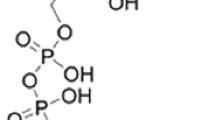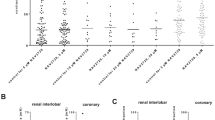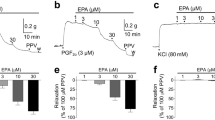Summary
Uridine 5′-triphosphate- (UTP-) and adenosine 5′-triphosphate-(ATP) induced vasoconstriction was studied in the rabbit basilar artery. The arteries were incubated and perfused at a constant rate of flow. Vasoconstriction was measured as an increase in perfusion pressure.
Serotonin, histamine and noradrenaline caused concentration-dependent vasoconstriction, with potency decreasing in that order. Of the nucleotides tested, UTP, UDP, UMP, CTP, ATP, ADP, adenosine 5′-O-(3-thio)triphosphate (ATPγS), and β,γ-imido adenosine 5′-triphosphate (AMP-PNP) elicited concentration-dependent vasoconstriction, whereas AMP, 2-methylthio-ATP, α, β-methylene-ATP and β,γ-methylene-ATP up to 10−3 mol/l caused no or only a very small increase in perfusion pressure. The order of potency of the pyrimidine nucleotides was: UTP = UDP ≫ UMP = CTP; that of the purine nucleotides was: ATPγS > AMP-PNP > ATP > ADP > 2-methylthio-ATP = α, β-methylene-ATP = β,γ-methylene-ATP. The vasoconstrictor effects of UTP and ATP were not or only to a minor degree influenced by: phentolamine; a mixture of atropine, diphenhydramine and methysergide; indometacin; nordihydroguaiaretic acid; denervation by 6-hydroxydopamine; or mechanical removal of endothelium. Prolonged exposure to α,β-methylene-ATP elicited only a very small vasoconstriction and did not change the constrictor effects of UTP or ATP. Prolonged exposure to ATPγS elicited marked vasoconstriction; subsequently, responses to ATP were reduced whereas those to UTP were, if anything, slightly enhanced. Reactive blue 2 reduced neither the UTP- nor the ATP-induced vasoconstriction. ATP 10−3 mol/l elicited marked additional vasoconstriction after precontraction with UTP 10−3 mol/l, whereas UTP elicited only a very small additional vasoconstriction when its concentration was doubled from 10−3 to 2 × 10−3 mol/l.
It is concluded that, in the rabbit basilar artery, the vasoconstrictor response to UTP is mediated by a pyrimidine nucleotide receptor which is distinct from the P2-purinoceptor, and that the vasoconstrictor response to ATP is mediated by a P2-receptor which is distinct from the known P2-subtypes.
Similar content being viewed by others
References
Aprigliano O, Hermsmeyer K (1976) In vitro denervation of the portal vein and caudal artery of the rat. J Pharmacol Exp Ther 198:568–577
Araki H, Su C, Lee TJF (1982) Effect of superior cervical ganglionectomy on the sensitivity of rabbit ear artery and cerebral arteries of rabbit and cat to vasoactive agents. J Pharmacol Exp Ther 220:49–55
Brown CM, Burnstock G (1981) The structural conformation of the polyphosphate chain of the ATP molecule is critical for its promotion of prostaglandin biosynthesis. Eur J Pharmacol 69:81–86
Burnstock G, Kennedy C (1985) Is there a basis for distinguishing two types of P2-purinoceptor? Gen Pharmacol 16:433–440
Burnstock G, Warland JJI (1987) P2-purinoceptors of two subtypes in the rabbit mesenteric artery: reactive blue 2 selectively inhibits responses mediated via the P2Y- but not the P2X-purinoceptor. Br J Pharmacol 90:383–391
Cockcroft S, Gomperts BD (1979) ATP induces nucleotide permeability in rat mast cells. Nature 279:541–542
Cockcroft S, Gomperts BD (1980) The ATP4− receptor of rat mast cells. Biochem J 188:789–798
Cusack NJ, Hourani SMO (1982) Competitive inhibition by adenosine 5′-triphosphate of the actions on human platelets of 2-chloroadenosine 5′-diphosphate, 2-azidoadenosine 5′-diphosphate and 2-methylthioadenosine 5′-diphosphate. Br J Pharmacol 77:329–333
Fedan JS, Hogaboom GK, Westfall DP, O'Donnell JP (1982) Comparison of contractions of the smooth muscle of the guinea-pig vas deferens induced by ATP and related nucleotides. Eur J Pharmacol 81:193–204
Goetz U, Da Prada M, Pletscher A (1971) Adenine-, guanine- and uridine-5′-phosphonucleotides in blood platelets and storage organelles of various species. J Pharmacol Exp Ther 178:210–215
Gordon JL (1986) Extracellular ATP: effects, sources and fate. Biochem J 233:309–319
Häussinger D, Stehle T, Gerok W (1987) Actions of extracellular UTP and ATP in perfused rat liver: a comparative study. Eur J Biochem 167:65–71
Hardebo JE, Hanko J, Owman C (1983) Differences between human intra- and extracranial arteries in their reactivity to vasoactive agents. Gen Pharmacol 14:133–134
Hardebo JE, Kåhrström J, Owman C (1987a) P1- and P2-purine receptors in brain circulation. Eur J Pharmacol 144:343–352
Hardebo JE, Kåhrström J, Owman C, Salford LG (1987b) Endothelium-dependent relaxation by uridine tri- and diphosphate in isolated human pial vessels. Blood Vessels 24:150–155
Jancar S, Schulz R, Krueger C, Cook DA (1987) Mechanisms of arachidonic acid-induced contractions of canine cerebral arteries. Eur J Pharmacol 136:345–352
Kawai Y, Ohhashi T, Azuma T (1984) The mode of ATP-induced vasoconstriction in the canine internal carotid artery. Blood Vessels 21:98–104
Keppens S, De Wulf H (1986) Characterization of the liver P2-purinoceptor involved in the activation of glycogen phosphorylase. Biochem J 240:367–371
Kiwak KJ, Heros RC (1987) Cerebral vasospasm after subarachnoid hemorrhage. Trends Neurosci 10:89–92
Lee TJF (1982) Cholinergic mechanism in the large cat cerebral artery. Circ Res 50:870–879
Lukacsko P, Krell RD (1982) Response of the guinea-pig urinary bladder to purine and pyrimidine nucleotides. Eur J Pharmacol 80:401–406
Meldrum LA, Burnstock G (1983) Evidence that ATP acts as a cotransmitter with noradrenaline in sympathetic nerves supplying the guinea-pig vas deferens. Eur J Pharmacol 92:161–163
Muramatsu I, Kigoshi S (1987) Purinergic and non-purinergic innervation in the cerebral arteries of the dog. Br J Pharmacol 92:901–908
Muramatsu I, Fujiwara M, Miura A, Shibata S (1980) Reactivity of isolated canine cerebral arteries to adenine nucleotides and adenosine. Pharmacology 21:198–205
Needham L, Cusack NJ, Pearson JD, Gordon JL (1987) Characteristics of the P2 purinoceptor that mediates prostacyclin production by pig aortic endothelial cells. Eur J Pharmacol 134:199–209
Rice WR, Singleton FM (1987) P2Y-purinoceptor regulation of surfactant secretion from rat isolated alveolar type II cells is associated with mobilization of intracellular calcium. Br J Pharmacol 91:833–838
Saiag B, Milon D, Guelou MC, Van Den Driessche J, Rault B (1987) Pharmacological evidence for the existence of P2 purinoceptors different from “pyrimidinoceptors” on arterial and venous smooth muscle. Abstracts of the 10th International Congress of Pharmacology, Sydney 1987, P 949
Saito A, Lee TJF (1987) Serotonin as an alternative transmitter in sympathetic nerves of large cerebral arteries of the rabbit. Circ Res 60:220–228
Seifert R, Burde R, Schultz G (1989) Activation of NADPH oxidase by purine and pyrimidine nucleotides involves G proteins and is potentiated by chemotactic peptides. Biochem J 259:813–819
Shirasawa Y, White RP, Robertson JT (1983) Mechanisms of the contractile effect induced by uridine 5-triphosphate in canine cerebral arteries. Stroke 14:347–355
Starke K, Peskar BA, Schumacher KA, Taube HD (1977) Bradykinin and postganglionic sympathetic transmission. Naunyn-Schmiedeberg's Arch Pharmacol 299:23–32
Tahir J (1989) The effect of in vitro denervation on transmitter release in the rabbit basilar artery. Br J Pharmacol 96:123P
Urquilla PR (1978) Prolonged contraction of isolated human and canine cerebral arteries induced by uridine 5′-triphosphate. Stroke 9:133–136
Urquilla PR, Van Dyke K, Trush M (1978) Structure-activity relation of pyrimidine nucleotides and nucleoside in canine isolated cerebral vessels. J Pharm Pharmacol 30:189–190
von Kügelgen I, Starke K (1985) Noradrenaline and adenosine triphosphate as co-transmitters of neurogenic vasoconstriction in rabbit mesenteric artery. J Physiol (Lond) 367:435–455
von Kügelgen I, Starke K (1988) Vasoconstrictor effect of UTP and ATP in rabbit basilar artery. Naunyn-Schmiedeberg's Arch Pharmacol 337:R44
von Kügelgen I, Häussinger D, Starke K (1987) Evidence for a vasoconstriction-mediating receptor for UTP, distinct from the P2 purinoceptor, in rabbit ear artery. Naunyn-Schmiedeberg's Arch Pharmacol 336:556–560
von Kügelgen I, Schöffel E, Starke K (1989) Inhibition by nucleotides acting at presynaptic P2-receptors of sympathetic neuro-effector transmission in the mouse isolated vas deferens. Naunyn-Schmiedeberg's Arch Pharmacol 340:522–532
Wallenstein S, Zucker CL, Fleiss JL (1980) Some statistical methods useful in circulation research. Circ Res 47:1–9
Wiklund NP, Gustafsson LE (1988) Indications for P2-purinoceptor subtypes in guinea pig smooth muscle. Eur J Pharmacol 148:361–370
Author information
Authors and Affiliations
Additional information
Send offprint requests to I. v. Kügelgen at the above address
Rights and permissions
About this article
Cite this article
von Kügelgen, I., Starke, K. Evidence for two separate vasoconstriction-mediating nucleotide receptors, both distinct from the P2X-receptor, in rabbit basilar artery: a receptor for pyrimidine nucleotides and a receptor for purine nucleotides. Naunyn-Schmiedeberg's Arch Pharmacol 341, 538–546 (1990). https://doi.org/10.1007/BF00171734
Received:
Accepted:
Issue Date:
DOI: https://doi.org/10.1007/BF00171734




